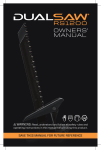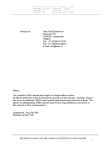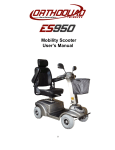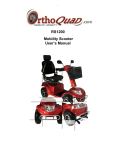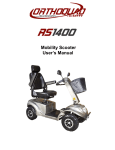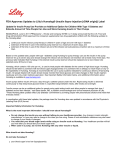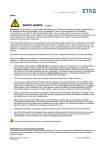Download Jupiter Scooter
Transcript
ES600 Mobility Scooter User’s Manual 0 TABLE OF CONTENTS I. Introduction 2 II. Specifications 3 III. Features 4 IV. Operating your scooter 5 V. Safety Instructions 7 VI. Battery Charging 11 VII. Maintenance Schedule 12 VIII. Warranty 13 1 I. INTRODUCTION Thank you for your interest in our scooter ES600. This scooter is a mobility assistive device designed for senior citizens who have walking difficulty or are weak in physical strength and for also for the disabled people. We designed this scooter to restore the dignity, equality and personal freedom, to provide convenience and comfort to you. This manual contains important information concerning the safe operation and proper maintenance of your scooters. Your ES600 has many unique features not found on other scooters. With proper care and maintenance, you should enjoy many years of dependable service from your unit. Your scooter should receive regular maintenance according to the schedule outlined in this manual, and the recommendation from the authorized dealer. By following the maintenance instructions, you will be able to take care of most of your unit’s needs. Above all, follow all service recommendation outlined in this manual to achieve the most trouble free, safe and enjoyable operation of your scooter. 2 ABOUT THE MANUAL The manufacturer reserves the rights of final interpretation on the manual. For any printing mistakes or new improvements, the manufacturer will update in the new editions. II. SPECIFICATIONS ES600 PERFORMANCE DATA Maximum forward speed Maximum backward speed Maximum Climbing Grade Load Capacity Ground Clearance Range with Full Charge Turning Radius 10 km/h 4.8 km/h 15 degrees 120kg - 250 pounds 6 cm Up to 40km 1.2m DIMENSIONS Length 51’’ Width 25’’ WEIGHT Total (with battery) 98kg – 215lbs BATTERY SPECIFICATIONS 12V/38 Ah Lead-acid battery BATTERY CHARGER Input AC /110V/60Hz Output DC24V/ 5amp MOTOR POWER 600W 3 III. FEATURES Modular construction - disassembles in one minute without use of tools Adjustable seat height Swing away armrests 360 degrees swivel seat Adjustable Forward/Reverse Seat Adjustable tiller Dynamic regenerative braking coupled with fail-safe electro-mechanical disk brake Rear wheel direct drive with differential Fully solid state controller External Battery Charger 24-volt permanent magnet heavy duty DC motor ON/OFF switch lock Horn Head light Turning lights Rear lights Battery-charging indicator Anti-tip-off safety wheels Front and rear bumpers Accessories adapter Automatic shut off while not in use Electronic High/Low speed switch 4 IV. OPERATING YOUR SCOOTER 1, BEFORE OPERATION 1). Insert the power key into the switch lock and turn clockwise to the ON position. 2). Check the battery charge indicator to make sure the batteries are fully charged. 3). Make sure that clutch lever is at close position. 2, TURN POWER ON Insert the key into the key switch on the upper tiller and rotate clockwise to the “ON” position. 3, FORWARD MOTION To move forward, pull the right thumb lever under the control console forward. The further you pull, the faster the scooter will go. The maximum speed may be selected by the speed selection switch located on the top of the control console. 3. REVERSE MOTION To reverse, pull the left side of the thumb lever under the control console forward. Reverse speed is limited to 3 mph (4.8 km/h). 4. STOP To stop the scooter, just release the thumb lever. The scooter will quietly come to a smooth stop and electromechanical brake will automatically engage to hold the scooter in position on horizontal surface or an incline of up to 12 degrees, with a load of no more than 265 lb. (120 kg). Quick smooth stops are made possible by the dynamic braking feature built in the controller. 5 Warning: The brake may not be effective when engaged on inclines greater than 15 degrees or 21% if the occupant’s weight exceeds 265 pounds. In case the brake fails to engage, the scooter may roll slowly on a slope. Turning off the key switch cuts off power off brake. 5. MOVE MANUALLY To move the scooter manually, release the clutch lever mounted on the gearbox. When in operation, the clutch release lever should be in its engaged position (forward). Should you wish to freewheel the Jupiter, pull the lever to its release position (backwards). Clutch Release for the scooter 6 V. SAFETY INSTRUCTIONS Your scooter can move on grass , gravel, dirt, and sand surfaces, as well as hard paved or carpeted surfaces. However, extra caution should be taken when operating your unit on uneven surfaces other than flat surfaces. There are some concerns about electromagnetic interference to powered wheelchairs and scooters. You need to know what EMI (Electromagnetic Interference) is and how to prevent such incidents. The following paragraphs suggested by the FDA are intended to provide you some important information about this. CAUTION: IT IS VERY IMPORTANT THAT YOU READ THIS INFORMATION REGARDING THE POSSIBLE EFFECTS OF ELECTROMAGNETIC INTERFERENCE ON YOUR POWERED SCOOTER. Electromagnetic Interference (EMI) From Radio Wave Sources Powered wheelchairs and motorized scooters (in this text, both will be referred to as powered wheelchairs) may be susceptible to electromagnetic interference (EMI), which is interfering electromagnetic energy (EM) emitted from sources such as radio stations, TV stations, amateur radio (HAM) transmitters, two-way radios, and cellular phones. The interference (from radio wave sources) can cause the powered wheelchair to release its brakes, move by itself, or move in unintended directions. It can also permanently damage the powered wheelchair’s control system. The intensity of the interfering EM energy can be measured in volts per meter (v/m). Each powered wheelchair can resist EMI up to certain intensity. This is called its “immunity lever.” The higher the immunity level, the greater the protection. At this time, current technology is capable of achieving at least a 20-v/m immunity level, which would provide useful protection from the more common sources of radiated EMI. The immunity level of this powered scooter as shipped, with no further modification, is not known. There are ample sources of relatively intense electromagnetic fields in the everyday environment. Some of these sources are obvious and easy to avoid. Others are not apparent and exposure is unavoidable. However, we believe that by following the warnings listed below, your risk to EMI will be minimized. 7 The sources of radiated EMI can be broadly classified into three types: 1) Hand-held portable transceivers (transmitters-receivers) with the antenna mounted directly on the transmitting unit. Examples include: citizens band (CB) radios, “walkie talkie,” security, fire, and police transceivers, cellular telephones, and other personal communication devices. **Note: Some cellular telephones and similar devices transmit signals while they are ON, even when not being used. 2) Medium-range mobile transceivers, such as those used in police cars, fire trucks, ambulances, and taxis. These usually have the antenna mounted on the outside of the vehicle; and 3) Long-range transmitters and transceivers, such as commercial broadcast transmitters (radio and TV broadcast antenna towers) and amateur (HAM) radios. Note: Other types of hand-held devices, such as cordless phones, laptop computers, AM/FM radios, TV sets, CD players, and cassette players, and small appliances, such as electric shavers and hair dryers, so far as we know, are not likely to cause EMI problems to your powered wheelchair. Powered Scooter Electromagnetic Interference (EMI) Because EM energy rapidly becomes more intense as one moves closer to the transmitting antenna (source), the EM fields from Hand-held radio wave sources (transceivers) are of special concern. It is possible to unintentionally bring high levels of EM energy very close to the powered scooter’s control system while using these devices. This can affect powered scooter movement and braking. Therefore, the warnings listed below are recommended to prevent possible interference with the control system of the powered scooter. WARNINGS Electromagnetic interference (EMI) from sources such as radio and TV stations, amateur radio (HAM) transmitters, two-way radios, and cellular phones can affect powered scooter and motorized scooters. Following the warnings listed below should reduce the chance of unintended brake release or powered scooter movement, which could result in serious injury. 1) Do not operate hand-held transceivers (transmitters-receivers), such as citizens band (CB) radios, or turn ON personal communication devices, such as cellular phones, while the powered scooter is turned ON. 8 2) Be aware of nearby transmitters, such as radio or TV stations, and try to avoid coming close to them; 3) If unintended movement or brake release occurs, turn the powered scooter OFF as soon as it is safe. 4) Be aware that adding accessories or components, or modifying the powered scooter, may make it more susceptible to EMI (Note: There is no easy way to evaluate their effect on the overall immunity of the powered scooter. 5) Report all incidents of unintended movement or brake release to the powered scooter manufacturer, and note whether there is a source of EMI nearby. If unintended motion or brake release occurs, turn the power OFF as soon as it is safe. FDA recommends that you report all incidents of unintended motion or brake release to us or your dealer, and if possible, note whether there was a radio wave source nearby at the time of the incident. You may also report to FDA’s MedWatch problem reporting program. Call 1-800-FDA-1088 and ask for Form 3500. The following warning label is included in order to make users always aware that a possibility of electromagnetic interference exists. WARNING: Radio wave sources may affect scooter control Radio waves sources, such as radio stations, TV stations, amateur radio (HAM) transmitters, cellular phones, and two-way radios, can affect motorized scooters. Following the warnings listed below should reduce the chance of unintended brake release or scooter movement, which could result in serious injury. 1). Do not turn ON or use hand-held personal communication devices, such as citizens band (CB) radios and cellular phones, while your scooter is turned ON; 2). Be aware of nearby transmitters, such as radio or TV stations and hand-held or mobile two-way radios, and try to avoid coming close to them. 3). If unintended movement or brake release occurs, turn the power OFF as soon as it is safe. 4). Be aware that adding accessories or components, or modifying your scooter, may make it more susceptible to interference from radio wave sources. (Note: There is no easy way to evaluate their effect on the overall immunity of the scooter), and 5). Report all incidents of unintended movement or brake release to the scooter manufacturer, and note whether there is a radio wave source nearby. Important Information: 1) 20 volts per meter (v/m) is a generally achievable and useful immunity lever, against interference from radio wave sources (as of May 1994) (the higher the lever, the greater the protection); 2) The immunity level of this product is not known. 9 In summary, - DO NOT try to climb sharp curbs. - DO NOT drive off or over obstacles exceeding 5 cm in height. - DO NOT make abrupt changes in direction at high speed or while traveling on an incline. - DO NOT climb inclines greater than 15 degrees or a rise of 2 meters in 10 meters. - DO NOT move backward on uneven surfaces or inclines. - DO NOT travel on highways and freeways; ALWAYS stay in the bike lanes or sidewalks. - DO NOT carry adult and child in any manner. - DO NOT operate your unit when the red battery indicator light is flashing. - DO NOT operate your unit with the clutch lever in the disengaging position. -DO NOT mount or dismount your unit with power switch in the “ON” position. - DO NOT turn ON or use hand-held personal communication devices, such as citizens band (CB) radios and cellular phones, while your scooter is turned ON. - ALWAYS make sure that the chassis lock pins are in position. - ALWAYS make sure that the steering tiller adjustment knobs are tight. - ALWAYS make sure that the seat is locked so that it will not swing during operation. - BE AWARE of nearby transmitters, such as radio or TV stations and hand-held or mobile two-way radios, and try to avoid coming close to them. -BE AWARE that adding accessories or components, or modifying your scooter, may make it more susceptible to interference from radio wave sources. 10 VI. BATTERY CHARGING To ensure the best performance and maximum battery life, we recommend frequent battery charging. Your scooter comes with an external battery charger for your ease and convenience. The console battery display makes charging simple and easy. Follow these steps for battery charging. 1). The console battery level display has two green lights (100% and 50%), one yellow light (25%), you’d better charge now), and one red light (almost empty, you must charge them right now). 2). On a dry surface, turn off the power key and plug the extension cord into the charger socket located on the steering column. Then plug the other end of the charger cord into a wall outlet. 3). Charge the battery for 8-10 hours depending on the usage before charging. Disconnect the extension cord, insert key into tiller and check if both green lights are on. If the right green light is flashing, remove the key and reconnect the charger for a while longer. 4). There is no possible way to overcharge the battery as the charging voltage is set constant. In general, you may start charging before you go to bed at night and disconnect it in the next morning. Battery Charger Hook up 11 VII. MAINTENENCE SCHEDULE In order to obtain the best performance and lasting service life, please maintain your unit according to the following schedule and instructions: DAILY Test brake effectiveness before you drive. Recharge battery fully every night. WEEKLY 1. Check tire pressure. Pressure should be 40 - 50 psi. 2. Clean seat upholstery, plastic body and covers. To avoid the electrical failure, do not spray water directly to your unit. Use a damp clean rag to clean all parts. 3. Check and tighten the throttle screw. MONTHLY 1. Check battery condition. Clean terminals if necessary. 2. Check all electrical wire connectors to eliminate loose connections. 3. Tighten all exposed bolts and nuts. 4. Check wheel bearings by spinning tires and checking for free rotation. YEARLY Visit your dealer and let technician check your scooter completely. 12 VIII WARRANTY To guarantee your benefits and the excellent after-sale service provided by the manufacturer, please read the following items carefully. I) GUARANTEE CONTENTS, TARGETS AND DEADLINE: a) guarantee contents: Purchase the unit from the manufacturer or authorized dealer. Operate according to the instructions set in this manual. The manufacturer guarantee to any quality problems concerns its manufacturing or materials within the guarantee period. 2. Guarantee target and deadline: from the date of purchase (1) The motor and gearbox is guaranteed to replace or to repair within a 2 year. (2) The battery is guaranteed 6 months after the date of purchase by the end-user.(customer) (3) All other RS1200 components are guaranteed for 1 full year after the date of purchase by the end-user.(customer) II) GUARANTEE IS NOT ENSURED WITH THE PROBLEMS CAUSED BY THE FOLLOWING: (1) (2) (3) (4) (5) (6) Do not operate according to the manual. Do not get maintenance from the specified dealers. Do not use the components or parts made by our corporation. Modify the unit or its part without authorization.. The warranty has expired. Incidents caused by uncontrollable factors such as typhoon, floods, fire, earthquake or war. 13















